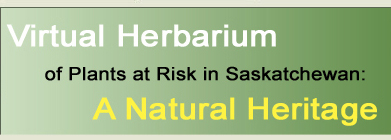|
| Viola conspersa
Reichenb. |
|
| |
| TAXONOMY |
| |
| Family: |
Violaceae |
| Genus: |
Viola |
| |
| Species Synonyms: |
none |
| Common Names: |
American dog violet |
| |
| DISTRIBUTION |
| |
| Canada: |
east-central Saskatchewan – southern Manitoba
– Ontario – Quebec – New Brunswick – Nova Scotia |
| Saskatchewan: |
east-central Saskatchewan; Pasquia Hills –
Fort Qu’Appelle |
| Ecoregion: |
Aspen Parkland, Boreal Transition, Mid-Boreal
Upland |
| |
| HABITAT |
| |
| Saskatchewan: |
moist deciduous or mixed woods
and clearings |
| |
| RARITY STATUS |
| |
Provincial
Status According
to Harms (2003): |
Endangered |
| Nature Conservancy
Status: |
G5 S1 |
Saskatchewan
Species at
Risk Status: |
None |
| COSEWIC Status:
|
None |
| |
| Viola conspersa
is endangered because it is rare in Saskatchewan. Possible threats have
been identified, including occurrences in heavy populated areas, fragile
habitats, or areas of possible planned developments. |
| |
| SPECIES
DESCRIPTION |
| |
| Rhizomes: |
taproot |
| Stems: |
perennial, leafy, erect |
| Leaves: |
alternate, petiolate, cordate-ovate to reniform,
base cordate or subcordate, apex rounded on upper leaves, thin, essentially
glabrous |
| Inflorescence: |
flowers solitary, axillary |
| Flowers: |
calyx 5-merous, eciliolate; corolla 5-merous,
spur less than 1 cm long, lateral petals bearded, pale violet; style recurved
and at least somewhat pubescent |
| Fruits: |
capsule 3-valved; seeds numerous |
| |
| VIOLA
KEY FOR SPECIES FOUND IN SASKATCHEWAN |
| |
| 1 Plants acaulescent; leaves and peduncles
arising from a caudex and/or plants with stolons |
2 |
| 1 Plants caulescent; flowers axillary,
stolons and caudex absent |
11 |
| |
|
2 Leaves deeply divided; plants of
prairies and dry areas
|
V. pedatifida |
| 2 Leaves toothed or lobed but not
deeply divided or margin entire; plants of meadows to moist woods or boggy
areas |
3 |
| |
|
| 3 Flowers white, may have purplish
lines towards the base |
4 |
| 3 Flowers blue to violet |
7 |
| |
|
| 4 Plants without stolons; leaves orbicular
to reniform |
V. renifolia |
| 4 Plants stoloniferous; leaves ovate
to reniform |
5 |
| |
|
| 5 Leaves pubescent, at least when
young; petioles and peduncles reddish |
V. blanda var. palustriformis |
| 5 Leaves glabrous; petioles and peduncles
greenish |
6 |
| |
|
| 6 Leaves 2 – 5 cm long, 2.5
– 3.5 cm wide |
V. palustris var. brevipes |
| 6 Leaves 1 – 2 cm long, 1 –
1.5 cm wide |
V. macloskeyi ssp. pallens |
| |
|
| 7 Rhizomes thick and fleshy; stolons
absent; caudex usually short and thick; lateral petals bearded or not; sepals
ciliolate or eciliolate |
8 |
| 7 Rhizome slender and cord-like; stolons
present or absent; caudex present or absent; lateral petals always bearded
(except V. selkirkii); sepals eciliolate |
10 |
| |
|
| 8 Spurred petal beardless |
V. sororia |
| 8 Spurred petal bearded |
9 |
| |
|
| 9 Sepals ciliolate |
V. septentrionalis |
| 9 Sepals eciliolate |
V. nephrophylla |
| |
|
| 10 Stolons present; petal spur much
shorter than the blade; lateral petals bearded; plants of moist meadows
and streams |
V. palustris var. palustris |
| 10 Stolons present; petal spur to
2/3 as long as blade; lateral petals beardless; plants of woods and rocky
slopes |
V. selkirkii |
| |
|
| 11 Leaves lanceolate to narrowly ovate;
flowers yellow, may have purple veins at the base |
12 |
| 11 Leaves cordate-ovate to reniform;
flowers yellow, white or blue |
13 |
| |
|
| 12 Leaves usually at least three times
as long as wide, lanceolate to elliptic |
V. nuttallii |
| 12 Leaves less than three times as
long as wide, narrowly ovate |
V. vallicola var. vallicola |
| |
|
| 13 Flowers yellow, with purplish-brown
veins; plants of rich deciduous woods |
V. pubescens var. scabriuscula |
| 13 Flowers white to lilac or blue;
plants of woods or meadows |
14 |
| |
|
| 14 Flowers white inside, yellow at
base and with purplish veins or purple tinge on outside; stipules entire |
V. canadensis var. rugulosa |
| 14 Flowers blue to lilac; stipules
toothed |
15 |
| |
|
| 15 Leaves thin, glabrous; stipules
ovate; flowers lilac |
V. conspersa |
| 15 Leaves thick, glabrous to densely
pubescent; flowers deep blue |
16 |
| |
|
| 16 Leaves densely pubescent |
V. adunca var. adunca |
| 16 Leaves glabrous |
V. labradorica |
|






